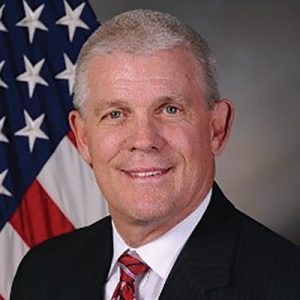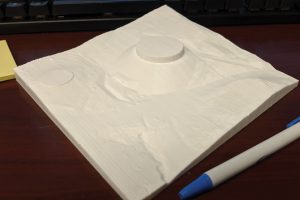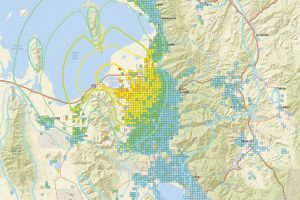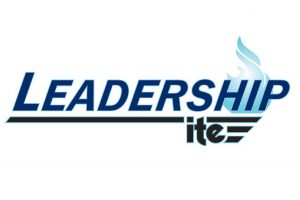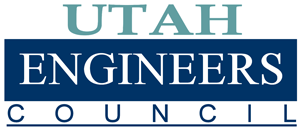Many of us can relate to Arthur Dent (the main character in The Hitchhikers Guide to the Galaxy). He is a mild-mannered guy trying to protect his house when he is plucked from the earth just before it is demolished to make way for a hyperspace bypass. I, myself, felt like “poor Arthur Dent” while writing this article on digital engineering.
Like many of you, I am seeking to understand and embrace digital engineering. To many of us, digital engineering is like that “tantalizing galaxy” outside our world … exciting, thrilling, and just waiting to be discovered and explored. This article will engage in a sharply humorous relation between the United States Air Force Digital Campaign and The Hitchhiker’s Guide to the Galaxy. Be prepared to learn more about the innovative realm of digital engineering and what possibilities lie beyond our grasp. Most of all, enjoy this article, share it with your friends, and have fun!
Body of Knowledge No. 1. The Integrated Digital Environment
Like Arthur Dent, I had to grasp that so much more exists beyond my house (the United States Air Force) and backyard (the United States Department of Defense) that beckons to be studied and understood as we move into the Digital Engineering Galaxy.

The first body of knowledge I would share is an integrated digital environment. An integrated digital environment is a compilation of data, models, and tools for collaboration, analysis, and visualization across all functional domains. The integrated digital environment includes the methodology and specifications for data, models, and tools arrangement with processes and procedures to exploit informational results.
The Air Force Digital Campaign needed categorization/taxonomies for the body of knowledge tools and models being proposed to perform various lifecycle phases of system research, design, development, test, sustainment, and disposal. During the Air Force Digital Campaign tools sprint, it was generally acknowledged that the Air Force owns and manages over 700 tools and applications, plus thousands of independently developed models that perform on:
- Personal computers
- Client-servers
- High-performance computers
- On-premise clouds, and
- State-of-the-art enterprise clouds
In other words, the tools, applications, and models form a very complex digital galaxy. With the size and complexity of tools available on the market, the team arranged this galaxy of tools into four areas of prominence:
- Model-based System Engineering
- Product-Lifecycle Management
- Analysis
- Visualization
To understand this digital galaxy transformation, we have presented Figures 1.0 and 2.0. Figure 1.0 is system engineering and management from the past. Figure 2.0 moves product lifecycle management into the future model-based digital engineering galaxy (beyond the clouds, the integrated digital environment, and crowd-sourced thinking).
For myself, my understanding was defined as moving from a paper to a virtual three-dimensional environment, as visualized in Figure 2.0.
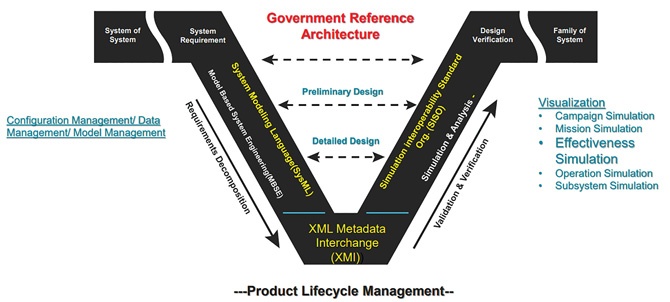
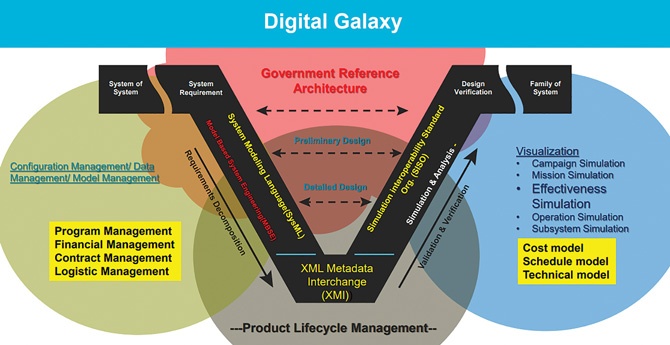
I worked from the international landscape using definitions from the International Council on System Engineering (INCOSE).1 INCOSE will be the primary source of these definitions and understanding. I also referred to the Office of the Secretary of Defense Digital Engineering Strategy,2 System Engineering Research Center,3 and the Air Force System Engineering Center.4 After that, I went into open-source literature — the big blue digital galaxy. In keeping with the theme, I highlighted the proposed definitions for the Air Force Digital Campaign guide in blue.
Model-based Systems Engineering
Feb. 26, 2020: INCOSE defines model-based systems engineering as “the formalized application of modeling to support system requirements, design, analysis, verification and validation activities beginning in the conceptual design phase and continuing throughout development and later life cycle phases.”1
Digital model-based engineering is the use of digital artifacts, digital environments, and digital tools in the performance of engineering functions.2 For a list of popular MBSE tools, please visit https://mbse4u.com/sysml-tools/.4
Product Lifecycle Management
Using product lifecycle management is not a new concept and has been part of system configuration management and data management processes; however, digital emphasizes the continuity of models across the lifecycle with the mission owner, acquirer, and product development.2
Product lifecycle management is “a systematic approach to managing the series of changes [and models] that a product goes through, from its design and development to its ultimate retirement or disposal.”5
Analysis
Formalize the development, integration, and use of models to inform enterprise and program decision-making. This support combines model-based systems engineering and product lifecycle management with consistent analysis and decision-making for programs across the enterprise.2
“Analysis is the examination of anything complex in order to understand its nature or to determine its essential features.”6
Visualization
Visualization techniques and tools are used to display the results in various visual forms to be processed so they can be presented to the users in a meaningful way.7
“Visualization is the act or process of interpreting in visual terms or of putting an object, situation, or set of information into visible form.”6

Body of Knowledge No. 2. Framing the Integrated Digital Environment for Acquisitions
We are in the throes of understanding the Digital Galaxy, which might look different and have different turns depending on your programs, knowledge, and, more importantly, your knowledge of the digital universe.
One notional body of knowledge example is in the graphic below (Figure 3.0), which shows a simple government integrated digital environment with multi-levels of security communities exchanging knowledge, models, and data from a contractor’s integrated digital environment, also at multi-levels of security. The two-dimensional graphic does not do the relationship justice since that bidirectional arrow happens at quantum speeds in the new digital galaxy.
One note of importance is that the integrated digital environment includes integrating programmatic information (such as the program manager, financial manager, logistics manager, and so on) with the engineering models and data, resulting in an environment that is a truly integrated acquisition program. It is not a paper-based product anymore, but a digital galaxy.
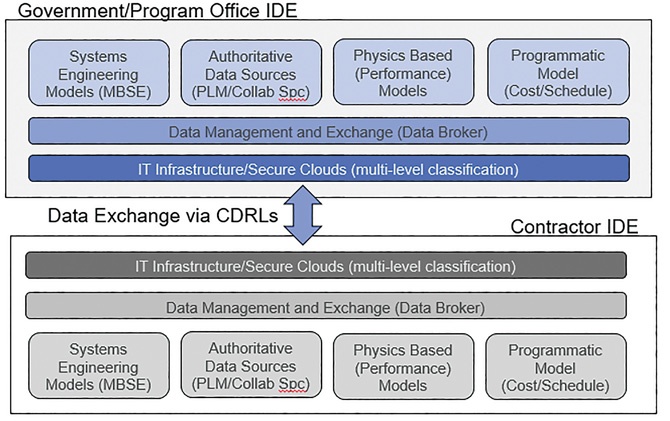
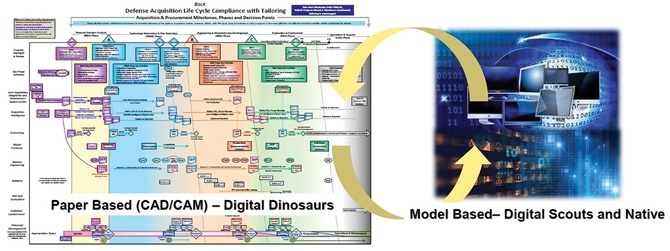
It is great to see defense acquisition laid out so clearly. It made complete sense to me. However, the step from a local understanding to understanding the galaxy was a giant and very complex leap for me. To develop my understanding, Arthur (I) ended up breaking it down into the chapters that have led into the digital galaxy:
#0: Integrated Environment — IT Infrastructure
Provide overarching guidance to influence corporate IT improvement investments and enable a robust, secure infrastructure for the enterprisewide Digital Campaign.
#1: Integrated Environment — Models and Tools
Provide an integrated digital environment of models and tools for collaboration, analysis, and visualization across the functional domains of Air Force users.
#2: Standards, Data and Architectures
Provide overarching guidance on using government reference architectures and related standards and datasets in an integrated digital environment to be applied at the enterprise and system levels.
#3: Lifecycle Strategies and Processes
Develop life cycle strategies and processes for technology transition, system acquisition and product support using an integrated digital environment, supporting lifecycle activities from concept development to disposal.
#4: Policy and Guidance
Assess and define the required policy and guidance updates or changes to enable digital transformation’s full implementation.
#5: Workforce and Culture
Drive cultural change across the Air Force Materiel Command enterprise through training and change management, enabling a workforce well-versed in digital engineering.
Body of Knowledge No. 3. Cultural Natives, Scouts, and Vagons (Dinosaur-Like Creatures)
Another knowledge point in body of knowledge 3 that Arthur (I) had to grasp was culture and cultural acceptance within the digital galaxy. As we explore culture, we take another detour around the galaxy, understanding people, pathfinders, and acceptance.
This section isn’t specifically about the previously discussed framework of the integrated digital environment. This section is a reflection of the Air Force Digital Campaign evaluation of the Air Force Digital Campaign community in the digital galaxy. As we gallivanted about the galaxy with its 10,000 people, industry, pathfinders, and programs, several common themes were revealed.
- Observation 1: There were digital natives in the galaxy. These natives accepted that the network, connections, and applications were always available. They just accepted this digital ecosystem as part of their daily life.
- Observation 2: Scouts were experiencing parts of the digital ecosystem (as they looked into clouds, microservices, agile software, and so on.). As a group, they were trying to utilize this new environment to the best of their ability through crowdsourcing models and ideas.
- Observation 3: I saw a third group that I termed “Vagons” (not a negative term) that were not as comfortable as the scouts and natives. They are cautious at every step as we see and experience more of the universe and as the digital galaxy starts to expand.
Don’t worry if you fit into any of those categories. Arthur continued to ask “Why?” in The Hitchhiker’s Guide to the Galaxy. You can, too.
So Long, and Thanks for All the Fish
Arthur and I hope you enjoyed The Hitchhiker’s Guide to the Digital Engineering Galaxy. The journey doesn’t stop here. We have a long way to go, and it is going to be a fantastic future!
Let’s recap some of the journey.
In body of knowledge No. 1, we learned the basic elements that make up the Digital Galaxy, such as model-based system engineering, product lifecycle management, analysis, and visualization. We also ran through the element descriptions to better understand this very complex, very integrated ![]() Analysis Visulization. The expansion of the sum of those four critical elements is larger than the individual elements:
Analysis Visulization. The expansion of the sum of those four critical elements is larger than the individual elements:
For me, concluding that those four elements are the only or completely correct four elements is just ludicrous at this stage of our digital galaxy journey.
In body of knowledge No. 2, we learned how to frame our understanding of this integrated digital environment relative to the further advancement of acquisition knowledge processes. We should embrace our legacy but recognize that our legacy should not restrict our advancement and adaptation of new truths thrust upon us as the complex digital galaxy is unveiled.
In body of knowledge No. 3, we recognized that everyone would not advance at the same pace while traversing the galaxy. We will recognize digital “Natives, Scouts, and Vagons.” We should strive to understand their cultures, perspectives, and backgrounds and leverage all these aspects as we moving into the new digital galaxy.
The Hitchhiker’s Guide to the Digital Galaxy finishes with body of knowledge 3.14 (Pi). If you remember, The Hitchhiker’s Guide to the Galaxy had two mice. They studied while the dolphins (the smartest mammals on the planet) were off playing and having fun.
As our Air Force Digital Campaign has studied the digital galaxy, we have concluded that:
- We are only starting our journey.
- We should pay attention to the fish. (The fish are the digital galaxy’s computer gamers who seem to have a lot of fun.)
The Air Force Digital Campaign has benefited from collaborative interactions and continues to gain from lessons learned from digital pathfinders, industry, and academic advisers. The Air Force Digital Campaign is expanding every day because of these collaborations and observations.
There is a long way to go seeking to understand the potential of this complex Digital Galaxy. The Galaxy is being realized through:
- The centralized computational power of the clouds
- The need for high-speed communication networks
- The important integrated environments, and
- Pilot understanding of improvements through machine learning and artificial learning
We know the ultimate answer is “42.” Now we need to find the ultimate question to the ultimate answer. So please, Marvin (a paranoid android): “Don’t panic.”
Special thanks to Mr. Paul White and Mr. Mark Kassan for guidance and consultation on this project.
References
- International Council on System Engineering (INCOSE), info@incose.org, 7670 Opportunity Rd, Suite 220 San Diego, CA 92111-2222 USA
- Digital Engineering Strategy, June 2018, Office of the Deputy Assistance Secretary of Defense for System Engineering, Washington, DC
- System Engineering Research Center, https://sercuarc.org/, Systems Engineering Research Center Located at Stevens Institute of Technology, 1 Castle Point on Hudson Hoboken, NJ 07030
- Popular SysML/MBSE Modeling Tools, https://mbse4u.com/sysml-tools/, Model Based Systems Engineering – Knowledge, Practice, and more.
- TechTarget, https://searcherp.techtarget.com/definition/product-lifecycle-management-PLM, no web date
- Merriam Webster Dictionary, https://www.merriam-webster.com/dictionary/analysis, 19 Dec 2020
- System Engineering Body of Knowledge, https://www.sebokwiki.org/, 14 October 2020
This Article was inspired by the following books by Douglas Adams:
- The Restaurant at the End of the Universe, Douglas Adams, 1980
- Life, the Universe and Everything, Douglas Adams, 1982
- So Long, and Thanks for All the Fish, Douglas Adams, 1984
Thomas A. Lockhart, Jr.
Thomas A. Lockhart, a senior executive service member, is the Director of Engineering and Technical Management, Air Force Nuclear Weapons Center, Hill AFB, Utah. He enhances warfighter support as the center’s lead for nuclear systems and digital engineering, weapon system integrity, cybersecurity, test and evaluation, workforce development, technology insertion, and multi-domain system support for Minuteman III, Air-Launched Cruise Missile, and Command and Control (C2).
Prior to his current assignment, Mr. Lockhart was the Air Force Research Laboratory’s director for both its Plans and Programs Directorate and its Strategic Development Planning and Experimentation Directorate, managing the processes that define Air Force Research Laboratory’s $2 billion annual investment in technologies for future Air Force systems and enable the alignment of Science and Technology resources.
Mr. Lockhart has had two tours in Iraq and Afghanistan. In his last tour as the NATO Resolute Support Essential Function for Sustainment, Kabul, Afghanistan, he exercised oversight of Afghanistan National Defense and Security Forces sustainment for 385,000 Ministry of Defense and Interior military and police forces’ yearly budgets of over $3.2 billion.
Mr. Lockhart began his career in 1987, working as a journeyman engineer in training and simulation at Hill Air Force Base, Utah. He has served as an engineer, chief engineer, acquisition program manager, group director, combatant command financial manager, deputy program executive officer (PEO) and security cooperation director.






